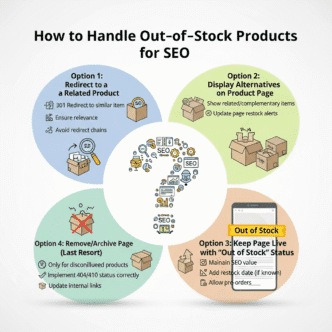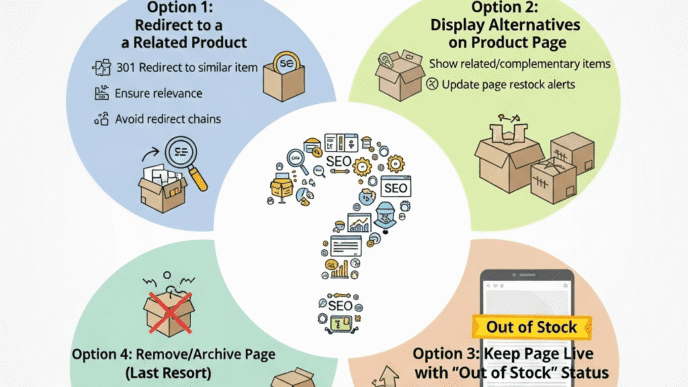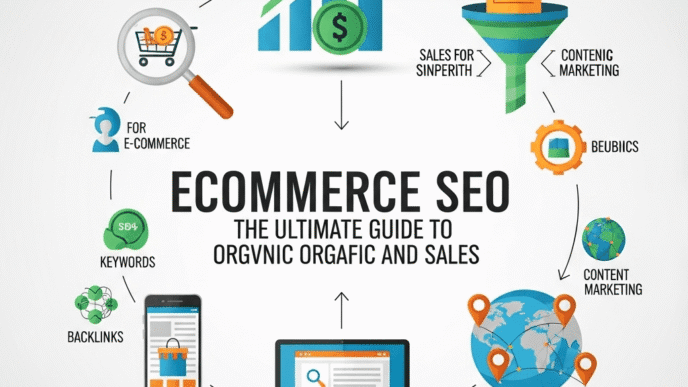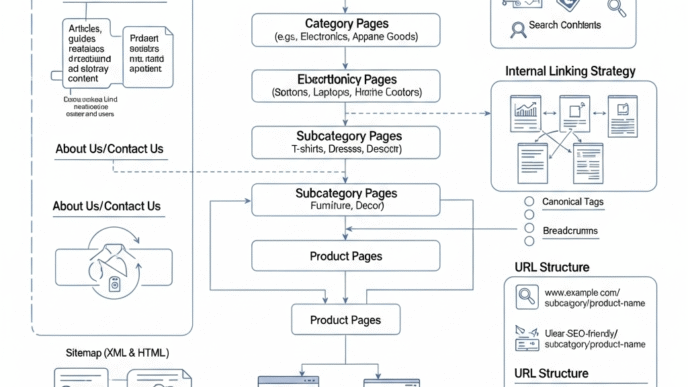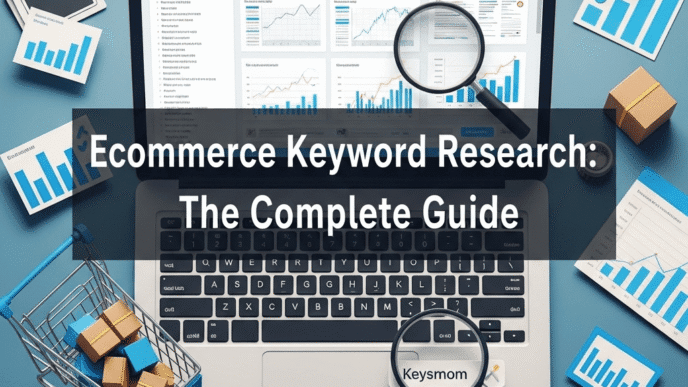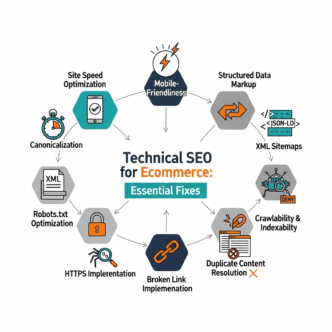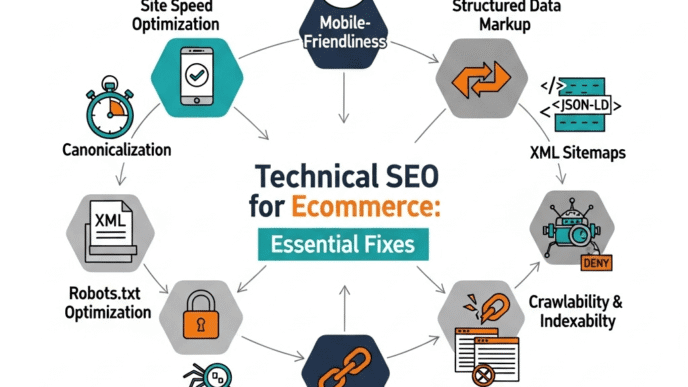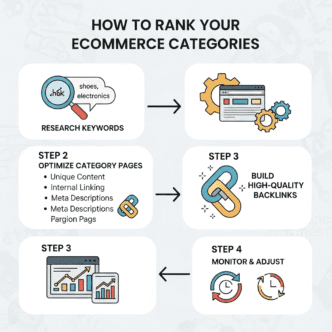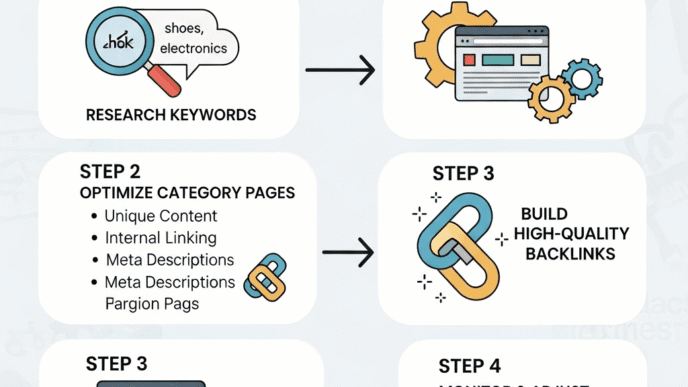Your products rank on page one. Traffic is decent. But somehow, competitors with lower rankings get more clicks. What gives?
The secret weapon they’re using? Schema markup for ecommerce—the invisible code that makes your search listings pop with star ratings, prices, stock availability, and eye-catching details that make shoppers click YOUR result instead of theirs.
This guide reveals exactly how to add schema markup to product pages so you capture more clicks, drive more traffic, and sell more products—without improving your rankings at all. Let’s turn your boring search listings into click magnets.
Table of Contents
Toggle
What Is Schema Markup and Why Should Ecommerce Stores Care?
Schema markup (also called structured data) is code that helps search engines understand exactly what’s on your page—product details, prices, reviews, availability, and more.
Think of it as translating your page into a language Google’s bots understand perfectly. Instead of guessing what information matters, you’re explicitly telling them “this is the price, this is the rating, this is the brand.”
The visible payoff? Rich snippets.
Rich snippets are those enhanced search results with extra information:
- ⭐ Star ratings (4.8 out of 5)
- 💰 Pricing information
- ✅ Stock availability
- 🚚 Shipping details
- 📝 Review counts
According to research by Search Engine Land, rich snippets can increase click-through rates by 30% or more. That’s 30% more traffic to your products without ranking a single position higher.
Pro Tip: According to Google’s own research, pages with properly implemented schema markup rank an average of 4 positions higher than pages without it. Schema doesn’t directly influence rankings, but the improved CTR and engagement signals indirectly boost your positions over time.
For the complete foundation of ecommerce SEO including schema implementation, check our ultimate ecommerce SEO guide.
Why Schema Markup for Ecommerce Is More Important in 2025
Google’s search results are more competitive than ever. Zero-click searches, AI overviews, and featured snippets mean organic listings get less attention.
Standing out is no longer optional—it’s survival.
The 2025 schema landscape:
- Google now supports more ecommerce schema types
- Rich snippets appear for more query types
- Voice search relies heavily on structured data
- AI search features pull from schema markup
- Mobile searchers especially respond to visual richness
Real stats: According to SEMrush, only 31.3% of websites use schema markup. That means implementing it gives you an instant advantage over 2 out of 3 competitors.
Pro Tip: Google’s Search Generative Experience (SGE) and AI Overviews heavily rely on structured data to understand and present information. Products with proper schema are more likely to appear in AI-generated results, giving you visibility even in the evolving search landscape.
What Types of Schema Markup Do Ecommerce Stores Need?
Not all schema types matter for online stores. Focus on these essential ones.
Essential Ecommerce Schema Types
| Schema Type | Purpose | Impact | Priority |
|---|---|---|---|
| Product | Product details, price, availability | High | Critical |
| Offer | Pricing, currency, stock status | High | Critical |
| AggregateRating | Average rating, review count | Very High | Critical |
| Review | Individual customer reviews | High | Important |
| Organization | Business information | Medium | Important |
| Breadcrumb | Navigation path | Medium | Recommended |
| FAQ | Common questions answered | Medium | Recommended |
| Video | Product videos | Medium | Optional |
Product Schema is the foundation—everything else builds on it.
How to Add Schema Markup to Product Pages: Step-by-Step
Let’s implement product structured data properly so Google actually displays your rich snippets.
Step 1: Understanding Product Schema Structure
Product schema includes these essential elements:
Required fields:
- name (product name)
- image (product image URL)
- description (product description)
- offers (pricing and availability information)
Recommended fields:
- brand (manufacturer/brand name)
- sku (stock keeping unit)
- aggregateRating (average rating)
- review (customer reviews)
Example Product Schema (JSON-LD format):
{
"@context": "https://schema.org/",
"@type": "Product",
"name": "Nike Air Zoom Pegasus 40",
"image": "https://yourstore.com/images/pegasus-40.jpg",
"description": "Lightweight running shoes with responsive cushioning",
"brand": {
"@type": "Brand",
"name": "Nike"
},
"sku": "NIKE-PEG40-BLK-10",
"offers": {
"@type": "Offer",
"price": "139.99",
"priceCurrency": "USD",
"availability": "https://schema.org/InStock",
"url": "https://yourstore.com/nike-pegasus-40"
},
"aggregateRating": {
"@type": "AggregateRating",
"ratingValue": "4.7",
"reviewCount": "234"
}
}
Pro Tip: Use JSON-LD format (JavaScript Object Notation for Linked Data) for schema markup. Google recommends it because it’s easier to implement, doesn’t clutter your HTML, and can be added via Google Tag Manager without touching your site’s code directly.
Step 2: Implementing Product Structured Data
Three ways to add schema:
Option 1: Manual Implementation Add JSON-LD code directly to your product page template in the <head> or <body> section.
Option 2: WordPress Plugins
- Yoast SEO (Premium)
- Rank Math SEO
- Schema Pro
- WooCommerce has built-in schema
Option 3: Shopify/BigCommerce Most modern themes include schema automatically. Verify it’s working correctly.
Manual implementation example:
<script type="application/ld+json">
{
"@context": "https://schema.org/",
"@type": "Product",
"name": "Organic Cotton Baby Onesie",
"image": [
"https://yourstore.com/images/onesie-front.jpg",
"https://yourstore.com/images/onesie-back.jpg"
],
"description": "100% organic cotton baby onesie, GOTS certified",
"brand": {
"@type": "Brand",
"name": "YourBrand"
},
"offers": {
"@type": "Offer",
"price": "24.99",
"priceCurrency": "USD",
"availability": "https://schema.org/InStock"
}
}
</script>
Pro Tip: Place schema code as high as possible in your HTML (ideally in <head> section) so Google’s crawlers encounter it immediately. This ensures proper parsing even if crawling is interrupted or JavaScript loading fails.
Learn more about technical SEO implementation in our comprehensive ecommerce guide.
Step 3: Adding Review Schema
Review schema is what makes those star ratings appear in search results—and stars dramatically increase clicks.
AggregateRating Schema:
{
"@context": "https://schema.org/",
"@type": "Product",
"name": "Product Name",
"aggregateRating": {
"@type": "AggregateRating",
"ratingValue": "4.8",
"reviewCount": "127",
"bestRating": "5",
"worstRating": "1"
}
}
Individual Review Schema:
{
"@context": "https://schema.org/",
"@type": "Product",
"name": "Product Name",
"review": {
"@type": "Review",
"author": {
"@type": "Person",
"name": "John Smith"
},
"datePublished": "2025-01-15",
"reviewBody": "Amazing product! Exactly as described...",
"reviewRating": {
"@type": "Rating",
"ratingValue": "5",
"bestRating": "5",
"worstRating": "1"
}
}
}
Pro Tip: Google requires a minimum of 3-5 reviews before displaying star ratings in search results. Focus on collecting genuine customer reviews first—schema without real reviews won’t show stars. Use post-purchase email campaigns to request reviews systematically.
Step 4: Implementing Offer Schema
Offer schema controls how pricing and availability appear in search results.
Complete Offer Schema:
{
"@type": "Offer",
"price": "299.99",
"priceCurrency": "USD",
"availability": "https://schema.org/InStock",
"url": "https://yourstore.com/product-url",
"priceValidUntil": "2025-12-31",
"seller": {
"@type": "Organization",
"name": "Your Store Name"
},
"shippingDetails": {
"@type": "OfferShippingDetails",
"shippingRate": {
"@type": "MonetaryAmount",
"value": "0.00",
"currency": "USD"
}
}
}
Availability values:
https://schema.org/InStock– Product availablehttps://schema.org/OutOfStock– Product sold outhttps://schema.org/PreOrder– Available for pre-orderhttps://schema.org/Discontinued– No longer available
Pro Tip: Always keep schema data synchronized with your actual product information. If schema shows “In Stock” but the page says “Sold Out,” Google may stop showing your rich snippets entirely or penalize your site for misleading information.
How to Get Rich Snippets in Google: Testing and Validation
Implementing product structured data is only half the battle. You need to ensure it’s working correctly.
Testing Your Schema Markup
Essential testing tools:
1. Google’s Rich Results Test
- URL: https://search.google.com/test/rich-results
- Tests if your page is eligible for rich results
- Shows preview of how results appear
- Identifies errors and warnings
2. Schema Markup Validator
- URL: https://validator.schema.org/
- Validates schema syntax
- Checks for required fields
- Identifies structural errors
3. Google Search Console
- Monitors rich result status
- Reports enhancement issues
- Shows which pages have valid schema
- Alerts to new errors
Pro Tip: Test every product page template, not just one example. Different product types (simple vs variable products, in-stock vs out-of-stock) may render schema differently. I’ve seen stores where 90% of products had valid schema but 10% had critical errors causing rich snippets not to appear.
Common Schema Errors and How to Fix Them
Error 1: Missing Required Field
Error: Missing field "price" (required field)
Fix: Ensure all required fields (name, image, price, availability) are present
Error 2: Invalid Property Value
Error: Invalid value for "availability"
Fix: Use exact schema.org URLs like "https://schema.org/InStock"
Error 3: Mismatched Data
Error: Schema price doesn't match visible price
Fix: Ensure schema data matches what users see on page
Error 4: Incorrect Date Format
Error: Invalid date format in "priceValidUntil"
Fix: Use ISO 8601 format: "2025-12-31"
Pro Tip: Set up monitoring in Google Search Console to receive alerts when schema errors appear. Schema can break after site updates, theme changes, or plugin conflicts. Regular monitoring catches issues before they hurt your rich snippet visibility.
What Schema Markup Looks Like in Search Results
Let’s see the visual impact of properly implemented schema markup for online stores.
Before Schema (Standard Listing):
Nike Air Zoom Pegasus 40 - Running Shoes
yourstore.com › products › nike-pegasus
Lightweight running shoes with responsive cushioning.
Free shipping on orders over $50. Shop now!
After Schema (Rich Snippet):
Nike Air Zoom Pegasus 40 - Running Shoes
⭐⭐⭐⭐⭐ 4.8 (234 reviews)
$139.99 · In stock
yourstore.com › products › nike-pegasus
Lightweight running shoes with responsive cushioning.
Free shipping on orders over $50. Shop now!
Notice the difference? Star ratings, price, and availability make the second listing impossible to ignore.
Real example: An outdoor gear store added schema to 500 product pages. Average CTR increased from 2.3% to 3.4%—a 48% improvement in clicks without any ranking changes. More clicks = more traffic = more sales, all from properly implementing schema.
Pro Tip: Rich snippets aren’t guaranteed. Google displays them at their discretion based on query relevance, competition, and quality signals. Focus on implementing perfect schema, collecting genuine reviews, and maintaining accurate product information. The rich snippets will follow.
Learn more about maximizing click-through rates in our ecommerce SEO ultimate guide.
Advanced Schema Implementation for Ecommerce
Once you’ve mastered basic product markup, these advanced techniques provide additional advantages.
1. Breadcrumb Schema
Breadcrumb schema shows navigation path in search results, helping users understand site hierarchy.
{
"@context": "https://schema.org",
"@type": "BreadcrumbList",
"itemListElement": [{
"@type": "ListItem",
"position": 1,
"name": "Home",
"item": "https://yourstore.com"
},{
"@type": "ListItem",
"position": 2,
"name": "Men's Shoes",
"item": "https://yourstore.com/mens-shoes"
},{
"@type": "ListItem",
"position": 3,
"name": "Running Shoes",
"item": "https://yourstore.com/mens-shoes/running"
}]
}
2. FAQ Schema
FAQ schema can earn featured snippet positions and provide additional SERP real estate.
{
"@context": "https://schema.org",
"@type": "FAQPage",
"mainEntity": [{
"@type": "Question",
"name": "What sizes do you offer?",
"acceptedAnswer": {
"@type": "Answer",
"text": "We offer sizes 6-13 in both regular and wide widths."
}
},{
"@type": "Question",
"name": "What is your return policy?",
"acceptedAnswer": {
"@type": "Answer",
"text": "We offer 30-day returns on all unworn products with original packaging."
}
}]
}
3. Video Schema
Video schema helps product videos appear in video search results and rich snippets.
{
"@context": "https://schema.org",
"@type": "VideoObject",
"name": "Nike Pegasus 40 Unboxing and Review",
"description": "Complete review of the Nike Air Zoom Pegasus 40",
"thumbnailUrl": "https://yourstore.com/video-thumb.jpg",
"uploadDate": "2025-01-15",
"duration": "PT5M30S",
"contentUrl": "https://yourstore.com/videos/pegasus-review.mp4"
}
Pro Tip: Combine multiple schema types on one page. A product page can have Product, Offer, AggregateRating, Review, Breadcrumb, FAQ, and Video schema all working together. Google pulls the most relevant data for each search context.
How AI Is Changing Schema Markup in 2025
Artificial intelligence is transforming how search engines use structured data for ecommerce.
AI-Powered Search Features
Google’s Search Generative Experience (SGE):
- Relies heavily on structured data to understand products
- Products with schema appear more prominently in AI overviews
- Proper markup helps AI accurately describe your products
- Missing schema means AI might misrepresent or skip your products
Voice Search and Smart Assistants:
- Voice results pull directly from schema data
- “What’s the price of [product]” answered via schema
- Product comparisons use schema for accurate info
- Availability questions rely on offer schema
Visual Search:
- Google Lens uses schema to identify products
- Image search results enhanced with schema details
- Shopping graph powered by structured data
Pro Tip: According to Google’s documentation, properly structured data is “essential” for appearing in AI-generated results and features. As AI search adoption grows, schema becomes less optional and more critical for visibility.
AI Tools for Schema Generation
AI-assisted schema creation:
- ChatGPT can generate schema based on product descriptions
- Tools like Frase and MarketMuse suggest schema improvements
- Automated schema generators reduce manual coding
- AI-powered validation catches errors before deployment
Pro Tip: Use AI to generate schema templates, but always validate with Google’s Rich Results Test. AI can hallucinate invalid property names or incorrect syntax. Human verification ensures accuracy before deployment.
Schema Markup Tools Comparison
| Tool | Type | Cost | Best For |
|---|---|---|---|
| Google Tag Manager | Implementation | Free | Managing schema without code changes |
| Yoast SEO | WordPress Plugin | $99/yr | WordPress/WooCommerce stores |
| Rank Math | WordPress Plugin | Free-$59/yr | Budget-friendly WordPress option |
| Schema Pro | WordPress Plugin | $79/yr | Advanced schema types |
| Merkle Schema Generator | Online Tool | Free | Quickly generating schema code |
| Google Rich Results Test | Testing | Free | Validating implementation |
| Schema.org | Documentation | Free | Learning schema types |
Pro Tip: Most ecommerce platforms (Shopify, BigCommerce, WooCommerce with plugins) include automatic schema generation. Verify it’s working correctly rather than assuming it’s implemented properly. I’ve audited stores with “automatic” schema that had critical errors preventing rich snippets.
Real-World Schema Implementation Case Study
Let’s examine a concrete implementing product structured data transformation with results.
The Business: Mid-sized jewelry retailer, 800 products, ranking well but low CTR
The Problem:
- Average organic CTR: 1.8% (page 1-3 positions)
- No rich snippets appearing in search results
- Competitors with lower rankings getting more clicks
- Zero schema markup implemented
- Product pages had reviews but no review schema
The Implementation (3-month project):
Month 1: Foundation
- Audited all product pages for schema opportunities
- Implemented Product schema on all 800 products
- Added Offer schema with accurate pricing and stock status
- Verified implementation with Rich Results Test
Month 2: Reviews and Ratings
- Implemented AggregateRating schema
- Added individual Review schema for top products
- Ensured minimum 5 reviews per product for star display
- Monitored Google Search Console for rich result status
Month 3: Enhancement
- Added Breadcrumb schema sitewide
- Implemented FAQ schema on category pages
- Added Organization schema to homepage
- Created monitoring system for schema errors
The Results (6 months post-implementation):
- Rich snippets appearing for 92% of products
- Average organic CTR: 1.8% → 3.2% (78% increase)
- Organic traffic increased 43% (same rankings)
- Conversion rate improved 12% (qualified traffic)
- Revenue from organic search: +$340,000 annually
- Competitor steal: captured clicks from higher-ranking competitors
Key Takeaway: They didn’t improve rankings at all. Simply making their existing listings more attractive with rich snippets captured dramatically more clicks and revenue. Schema gave them a competitive advantage without outranking anyone.
For comprehensive technical SEO integration, see our ecommerce SEO guide.
Schema Markup Checklist for Ecommerce
Your actionable schema markup for online stores implementation checklist:
Product Pages
- [ ] Product schema with name, image, description
- [ ] Offer schema with price, currency, availability
- [ ] Brand schema for manufacturer information
- [ ] SKU or product ID included
- [ ] AggregateRating schema (if 5+ reviews)
- [ ] Individual Review schema for testimonials
- [ ] Multiple product images in schema
- [ ] Breadcrumb schema for navigation
Category Pages
- [ ] Breadcrumb schema
- [ ] ItemList schema for product listings (optional)
- [ ] FAQ schema if relevant questions answered
Homepage
- [ ] Organization schema with business details
- [ ] Logo and social profile links
- [ ] Contact information
Testing and Validation
- [ ] Test with Google Rich Results Test
- [ ] Validate with Schema.org validator
- [ ] Monitor in Google Search Console
- [ ] Check for errors weekly
- [ ] Verify data matches visible page content
Ongoing Maintenance
- [ ] Update schema when prices change
- [ ] Adjust availability status for stock changes
- [ ] Add new reviews to review schema
- [ ] Monitor rich snippet appearance
- [ ] Fix errors immediately when detected
Expert Insights on Schema Markup
John Mueller, Google Search Advocate:
“Structured data helps us understand your content better and display it more attractively in search results. While it’s not a ranking factor per se, the improved click-through rates from rich snippets create positive engagement signals that can indirectly benefit rankings.”
Lily Ray, SEO Director at Amsive Digital:
“Schema markup is low-hanging fruit that most ecommerce stores either ignore or implement poorly. Proper schema implementation can deliver 30-50% CTR improvements, which translates directly to more revenue without any additional marketing spend.”
Barry Schwartz, Search Engine Roundtable:
“I’ve seen Google become increasingly reliant on structured data for understanding ecommerce content. Products without proper schema are at a significant disadvantage in search visibility, especially as AI-powered features become more prominent.”
These experts agree: schema markup for ecommerce isn’t optional anymore—it’s essential for competitive search visibility and maximizing organic traffic value.
Frequently Asked Questions
Does schema markup improve rankings?
Not directly. Schema helps Google understand your content but isn’t a ranking factor. However, improved CTR from rich snippets creates positive engagement signals that can indirectly boost rankings over time.
How long until rich snippets appear?
Google needs to recrawl and reprocess your pages, which typically takes 2-4 weeks. Rich snippets aren’t guaranteed—Google displays them at their discretion based on quality and relevance signals.
Do I need schema on every product page?
Yes. Consistent schema implementation across all products ensures maximum rich snippet coverage. Missing schema on some products means missing click opportunities.
What if my platform already includes schema?
Verify it’s implemented correctly and completely. Many platforms include basic schema but miss important elements like reviews or detailed offer information. Test with Rich Results Test tool.
Can I have too much schema?
No, as long as it’s accurate and relevant. Multiple schema types on one page (Product + Breadcrumb + FAQ + Video) work together to provide comprehensive information.
Why aren’t my star ratings showing?
Common reasons: fewer than 5 reviews, schema errors, mismatched data, or Google chooses not to display them for that query. Verify schema validity and ensure sufficient review volume.
Do I need different schema for product variations?
Generally no. Use one Product schema with Offer representing the default or most popular variation. Use canonical tags to prevent duplicate content from creating multiple schema versions.
Should I hire someone to implement schema?
If you’re comfortable with basic HTML/JSON, you can implement it yourself using tools and plugins. For large stores or complex implementations, hiring an expert saves time and ensures accuracy.
Final Thoughts: Schema Is Your Competitive Advantage
Schema markup for ecommerce is one of the few SEO tactics delivering immediate, measurable results without improving rankings. More attractive search listings = more clicks = more revenue.
The beautiful part? Most online stores either don’t have schema or implement it poorly. This gives you a massive advantage—capture clicks from competitors simply by making your listings more visually appealing and informative.
Implementation isn’t complicated. Modern platforms and tools make adding schema straightforward. The hard part is being thorough—implementing it on every product page, keeping it accurate, and monitoring for errors.
Start today:
- Test 5-10 product pages with Rich Results Test
- Fix any errors discovered
- Implement Product + Offer + Review schema on all products
- Add Breadcrumb schema sitewide
- Monitor Search Console for rich result status
Every product without schema is a missed opportunity. Every search listing without rich snippets loses clicks to competitors who implemented it properly.
Stop letting competitors steal your clicks with prettier search listings. Start capturing the traffic and sales your rankings deserve.
Master complete ecommerce SEO: Our comprehensive guide covers technical optimization, keyword research, content strategy, and link building that complement schema markup for maximum organic growth.
Get actionable SEO insights: Visit seoprojournal.com for expert guides, case studies, and proven tactics that drive measurable results for online stores.
Schema Markup for Ecommerce Dashboard
Interactive Guide to Rich Snippets and CTR Boost
Rich Snippet CTR Impact
Key Finding: Products with rich snippets (star ratings, price, availability) can increase click-through rates by 30% or more compared to standard listings.
Search Listing: Before vs After Schema
Visual Impact: See the dramatic difference schema markup makes in how your products appear in Google search results.
yourstore.com › products › nike-pegasus
Lightweight running shoes with responsive cushioning. Free shipping on orders over $50. Shop now!
⭐⭐⭐⭐⭐ 4.8 (234 reviews)
$139.99 · In stock
yourstore.com › products › nike-pegasus
Lightweight running shoes with responsive cushioning. Free shipping on orders over $50. Shop now!
Real Impact
A jewelry retailer implemented schema on 800 products and saw CTR increase from 1.8% to 3.2% (78% improvement) without any ranking changes. This translated to 43% more organic traffic and $340,000 additional annual revenue.
Essential Schema Types for Ecommerce
Priority Guide: Not all schema types are equally important. Focus on these essential types for maximum impact.
🔴 Critical
Product SchemaName, image, description, brand
🔴 Critical
Offer SchemaPrice, currency, availability
🔴 Critical
AggregateRatingStars, rating value, review count
🟡 Important
Review SchemaIndividual customer reviews
🟡 Important
Breadcrumb SchemaNavigation path in results
🔵 Recommended
FAQ SchemaCommon questions answered
Basic Product Schema Example
JSON-LD Format: Google recommends this format because it's easy to implement and doesn't clutter your HTML.
Testing Tools
→ Tests if page is eligible for rich results
2. Schema Markup Validator
→ Validates schema syntax and structure
3. Google Search Console
→ Monitors rich result status and errors
Pro Tip
Place schema code in the <head> section of your HTML so Google's crawlers encounter it immediately. This ensures proper parsing even if crawling is interrupted or JavaScript fails to load.
Schema Implementation Results Timeline
Real Case Study: A jewelry store implemented schema on 800 products and tracked results over 6 months.
Key Takeaway
Schema markup delivered measurable results without any ranking improvements. The store captured more clicks from competitors simply by making their search listings more attractive and informative with rich snippets.




